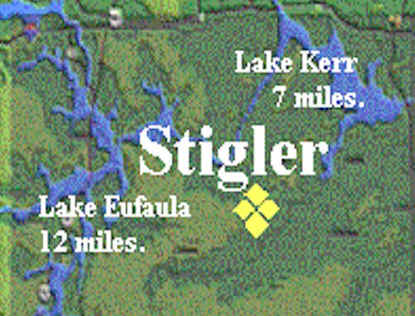|
Oklahoma Joe, (your Oklahoma guide).
Well, having lived in Seattle for much of my life, I know what
most of you people are thinking when you think of Oklahoma.
Either, Indians, Oral Roberts, the dust bowl, or (I hate to say it)
the Sooners.
Well, there's a whole other state out there.
A lot of its a "state of mind", but there really are gems in
Oklahoma that stand up to anywhere I've been.
I've seen water front property that rivals any in Seattle, but the
difference is, in Oklahoma you get an acre for what a square foot cost
in Seattle.
I'm probably going to get in a lot of trouble for telling you about
some of the places, many Okie's had just as soon keep them a
secret.
Some of them are such hidden treasure I'm going to make you dig a
little before divulging there actual location.
These places are so spectacular you'd think everyone would know about
them,
but you see, the Okies won't tell you about them, because they're
afraid you'll think they are bragging and get them confused for
Texans.
The Canadian River, the largest tributary of
the Arkansas River, rises in the Sangre de Cristo Mountains in
southern Las Animas County, Colorado, near Raton Pass and the boundary
line with New Mexico. It flows south and southeastward, separating the
Llano Estacado from the northern High Plains. It is roughly 760 miles
long; a stretch of about 190 miles is in Texas.
The river is dammed to form the Conchas and
Ute reservoirs in northeastern New Mexico before it enters Texas at
about the midpoint of the western boundary of Oldham County. The
Canadian crosses the Panhandle, flowing eastward and northeastward
with most of the river's course across the Panhandle passes through a
gorge 500 to 800 feet below the plateau. After crossing the state line
back into Oklahoma, the Canadian River flows generally southeastward
to its mouth on the Arkansas
River.
SPIRO MOUNDS.
Spiro Mounds, one of Oklahoma's most important prehistoric American
Indian sites, is located in LeFlore County on the southern bank of the
Arkansas River about fifteen miles from Fort Smith, Arkansas. The
Spiro Mounds site grew from a small farming village to one of the most
important centers in what later became the United States. Between 850
and 1450 A.D. twelve mounds, ceremonial areas, and a support city were
eventually created for the Caddoan-speaking leadership who
participated in the Mississippian Culture (also known as the
Southeastern Ceremonial Complex, the Southern Death Cult, and the
Buzzard Cult).
The Mississippian Culture
was a loosely organized trading, religious, and political system that
included the leadership from many language groups and several million
people. This confederation had trade connections stretching from the
Rocky Mountains to the Virginia coast and from the Gulf Coast of
Florida to the Great Lakes. Each group was more or less independent
although tied to the four regional mound centers. These regional mound
centers included Cahokia, where East Saint Louis is now, Moundville in
Alabama, Etowah in Georgia, and Spiro in eastern Oklahoma.
The twelve mounds of the
Spiro Mounds complex, all of human origin, were constructed in layers
from basket loads of dirt. Three types of mounds were built at the
Spiro Mounds site: one burial mound, two temple mounds, and nine house
mounds. While most of the mounds were for buildings to be placed upon
or to cover old houses, the single burial mound attracted the most
attention.
The Spiro Mounds site is
world renowned because of the incredible amount of art and artifacts
dug from the Craig Mound, the site's only burial mound. From the 1870s
Choctaw and Chickasaw freedmen farmed the land within the complex, but
the mounds remained undisturbed until 1917. At that time, Joseph
Thoburn, who had taken photographs of the site in 1914, tested Ward
Mound One, a buried house mound. The landowners discouraged further
work until 1933 when commercial diggers calling themselves the Pocola
Mining Company acquired the lease for the Craig Mound. From 1933 until
1935 Pocola employees dug haphazardly into the burial mound. During
two years, the commercial diggers destroyed about one-third of the
mound and sold thousands of artifacts, made of stone, copper, shell,
basketry, and fabric, to collectors throughout the world. Dubbed the
"King Tut of the Arkansas Valley" by the Kansas City Star in
1935, the site yielded artifacts in greater numbers, in better
preservation, and showing more elaborate, artistic, sophisticated
decoration than any other Mississippian site. Continuing destruction
convinced the Oklahoma Legislature to pass a licensing requirement for
the protection of the site, and in November 1935 the Pocola Mining
Company was finally shut down.
In 1936 the University of
Oklahoma (OU) began scientific excavation of what remained of the
burial mound. From June 1936 until October 1941 University of Oklahoma
archaeologists oversaw Works Progress Administration (WPA) workers in
systematically investigating the Spiro Mounds site. From the Craig
Mound more than six hundred complete or partial burials were recovered
along with thousands of artifacts. The OU and WPA crews also worked on
the other eight mounds recognized at the time. All of these structural
mounds were researched, although they still have some portions intact.
In 1941 the University of Oklahoma ended excavations because of World
War II and the demise of the WPA.
The land continued to be
privately owned and farmed until the mid-1960s when the U.S. Army
Corps of Engineers purchased most of the mound center to create a
national archaeological park, which did not materialize. On May 9,
1978, the Spiro Mounds Archaeological State Park, with the help of the
Oklahoma Archeological Survey, opened an Interpretive Center as the
first, and still only, Oklahoma prehistoric American Indian
archaeological site open to the public. The facility is under the
direction of the Oklahoma Tourism and Recreation Department. In 1979
the Oklahoma Archeological Survey conducted additional research at
Spiro Mounds Archaeological State Park, and three additional mounds
were located. One of these, a house mound, was tested in 1979 and
1980, and the other two will remain undisturbed. Spiro Mounds Group
was listed on the National
Register of Historic Places in 1969 (NR 69000153). In 1991 site
administration transferred to the Oklahoma Historical Society. An
expanded Interpretive Center at Spiro Mounds Archaeological Center and
an interpretive trail system allow visitors to learn about this unique
and powerful part of Oklahoma's past.
Tell us where yago.
info@yago.com
|
 Welcome
to Stigler.
Welcome
to Stigler.
 Welcome
to Stigler.
Welcome
to Stigler.
